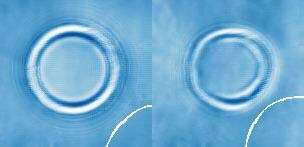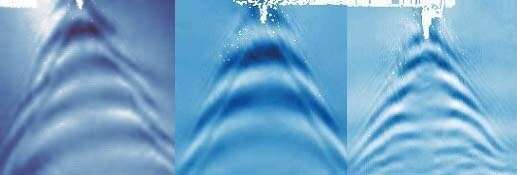
He solved a 127-year-old physics problem on paper and proved that off-centered boat wakes could exist. Five years later, practical experiments proved him right.
"Seeing the pictures appear on the computer screen was the best day at work I've ever had," says Simen Ådnøy Ellingsen, an associate professor at NTNU's Department of Energy and Process Engineering.
That was the day that Ph.D. candidate Benjamin Keeler Smeltzer and master's student Eirik Æsøy had shown in the lab that Ellingsen was right and sent him the photos from the experiment. Five years ago, Ellingsen had challenged accepted knowledge from 1887, armed with a pen and paper, and won.
He solved a problem regarding the so-called Kelvinangle in boat wakes, which has been unchallenged for 127 years. The boat wake is the v-shaped pattern that a boat or canoe makes when moving through the water. You've undoubtedly seen one at some point.
39 degrees
It has long been assumed that the angle of the v-shaped wake behind a boat should always be just below 39 degrees, as long as the water isn't too shallow. Regardless whether it's behind a supertanker or a duck, this should always be true. Or not. For like so many accepted facts, this turns out to be wrong, or at least not always the case. Ellingsen showed this.
"For me, it was a totally new field, and nobody told me it was hard," Ellingsen explained when he first made his discovery.

Boat wakes can actually have a completely different angle under certain circumstances, and can even be off-centered with respect to the direction of the boat. This can happen when there are different currents in different layers of water, known as shear flow. For shear flow, Kelvin's theory on boat wakes isn't applicable.
"It took the genius of people like Cauchy, Poisson and Kelvin to solve these wave problems for the first time, even for the simplest case of still water without currents. It's far easier for us to figure out the more general cases later, like we've done here,"Ellingsen explains.
Oblong rings
Ring waves also act funny under certain circumstances. If you throw a pebble in a lake on a peaceful summer's day, the wave pattern will be perfect, concentric circles. But not if there's shear flow. Then, the rings might turn into ovals. Ellingsen also predicted this, expanding Cauchy and Poisson's theory from 1815.
"After I did the first calculations, I was on a beach in the Netherlands watching the water flow back out after a wave. I made some rings in the water and took some photos. Looking at them later, the rings looked oblong to me, and I got pretty excited. That wasn't science, of course, but now it is!" says Ellingsen.
Lab research backs up calculations
That was how Ellingsen ended up on the cover of the Journal of Fluid Mechanics. But all of his calculations had been done on paper, and had yet to be observed empirically.

Now, however, there's lab research to back up his work, thanks to the Ph.D. candidate and master's student who were able to conduct experiments in a specially developed research tank, with Ellingsen as their supervisor.
Eirik Æsøy has a background as a technician, which saved time and money in building the lab. It took about six months to get everything up and running.
"Æsøy and I set up all the equipment to create the currents we needed," Smeltzer explains. Their results have also been published in the Journal of Fluid Mechanics.
"It's pretty remarkable that the experiments from our little wave basin are being published there," says Smeltzer.
Practical applications
The results from their research on the Kelvin angle might have real practical consequences, such as potentially helping reduce fuel consumption in ships. A large portion of fuel on ships actually goes into making waves.
"Fuel consumption can double if the vessel is traveling downstream compared to upstream," Ellingsen said.
These calculations are made based on currents at the mouth of the Columbia River in Oregon in the U.S.. Here the currents are strong and the boats many.
So research on boats and ships in different currents is important for anyone interested in reducing fuel consumption and consequently, emissions.
Boat wake in front of the boat
Ellingsen insists their results do not disprove Kelvin's theory, only extend it. Kelvin's angle still holds true as long as there are no current layers under the surface when the water is deep.
But as soon as there's movement between layers of water, so that different layers move at different speeds, the angle changes. Sometimes by a lot. In theory, with extremely strong currents moving perpendicular to the direction of the boat, the wake can actually end up in front of the boat on one side.
"Then you should probably go sailing somewhere else," says Ellingsen.
Explore further
Citation: A 127-year-old physics riddle solved (2019, August 21) retrieved 21 August 2019 from https://phys.org/news/2019-08-year-old-physics-riddle.html
This document is subject to copyright. Apart from any fair dealing for the purpose of private study or research, no part may be reproduced without the written permission. The content is provided for information purposes only.
https://phys.org/news/2019-08-year-old-physics-riddle.html
2019-08-21 12:08:06Z
CAIiENPb6QMjQcEcqeisO7ZZj8YqFwgEKg8IACoHCAowpbDpAzCm_hwwj9kp
Bagikan Berita Ini














0 Response to "A 127-year-old physics riddle solved - Phys.org"
Post a Comment